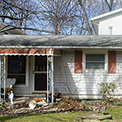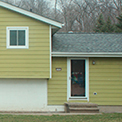These homes were built in the 1950s in a new sub-development just west of the Ohio Erie Canal, in a region used as seasonal hunting grounds by Native Americans between 1000 and 1600 AD. These natives, peoples of the Whittlesey Tradition, hunted deer, elk, and black bear and planted maize, beans, and squash. Due to persistent dangers of flooding, these people wisely built no permanent dwellings on the land. The modern settlers who later built here in this valley faced certain consequences, specifically the perennial threat of damage to properties from high waters.
These later settlers constructed ranches and split levels in the architectural parlance of our times, contemporary buildings with few distinguishing features, readily conforming to any stylistic context. Unfortunately, but not unsurprisingly, many homes flooded, and indeed, they did so year after year. The Army Corps of Engineers, the Federal Emergency Management Agency, and state and local agencies created responses to mitigate the effects of these acknowledged, expected, and regularly occurring natural disasters. These pre-disaster projects include structurally elevating the single-family homes, and raising the foundations beneath. The houses shown here are recipients of grants to undertake this work.
This raising solution requires needle beams to be placed beneath the first story of a house, and for these beams to be jacked up in unison. Masons lay additional courses of block as required to raise the house substantially above base flood elevation. The house is thereafter lowered in place upon the new, taller foundation. Stairs, platforms, and landings are built to provide access to the taller homes, and often these are covered. Utilities are rerouted. Because many services need to be relocated from the (former) basement, many homes receive small additions for furnaces and water heaters. The entire construction process can feasibly be completed within one building season.



